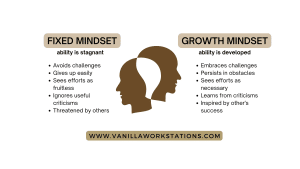
One of the difficulties teachers encounter is cultivating a growth mindset in the classroom. Teaching students how to understand, absorb, and apply new information and concepts is difficult in any situation. However, the task is considerably more difficult when students are unsure of their learning capacity. One way to solve this is by fostering a growth mindset in the classroom so students will be more motivated and willing to engage with new knowledge and skills.
What is Growth Mindset?
A growth mindset is a term coined by psychologist Carol Dweck, which means the belief that intelligence and abilities can be developed. In other words, it is the belief that you are not born with a certain amount of intelligence or ability but that these things can be cultivated through hard work and dedication. A growth mindset allows people to embrace challenges and learn from their failures. It is this type of thinking that leads to success in life.
A growth mindset is characterized by the following:
- Learning from failure – This is perhaps one of the most important aspects of growth mindset. When students can learn from their failures and mistakes, they are more likely to try new things, take risks, and persevere in the face of adversity.
- Openness to new ideas and perspectives – Another key trait of a growth mindset is an openness to different ways of thinking and seeing the world.
- Resilience – A growth mindset is also characterized by resilience and the ability to bounce back from setbacks. With a growth mindset, students are more likely to keep trying, even when things get tough, and they learn to embrace failure as an opportunity for growth.
- Excitement in challenges – This mindset also means that students are motivated and eager to learn, even when they encounter challenges or difficulties in the learning process.
- Self belief – This is the belief in one’s own capacity to learn and grow, which is essential for success both inside and outside the classroom.
- Positivity – A growth mindset is characterized by a positive outlook and an optimistic disposition that helps students persevere.
Fixed mindset VS Growth Mindset

This differs sharply from a fixed mindset, which assumes that our abilities are innate and unchangeable. People with fixed mindsets see challenges and setbacks as negative and avoid risk-taking or failure at all costs. While a growth mindset is beneficial for students of all ages and levels, it is particularly important for young learners who are still developing their self-identity.
A fixed or growth mindset affects how people react to failure. People with a fixed mindset think failing means they’re not good enough, whereas those with a growth mindset see it as a chance to improve and work harder and smarter.
Goals can indicate the difference between a fixed and a growth attitude. People with fixed-mindset desire to look smart because if they appear otherwise, they think it reveals they’re weak. People with a growth mindset don’t care what others think of their intelligence since they feel they can get smarter and better with effort. Fixed and growth mindsets have opposite learning goals. Fixed-mindset people want to avoid looking stupid, while growth-mindset people seek to conquer problems.
For students, a growth mindset requires a change in thinking about intelligence and ability. Rather than seeing them as static, fixed traits, students with a growth mindset understand that their ability to learn and grow is limitless. With this, students will be more willing and motivated to engage with new knowledge and skills in the classroom, ultimately benefiting them in the long run.
Methods for Teaching Growth Mindset in the Classroom
So how can educators cultivate a growth mindset in the classroom? Here are some strategies you can use to foster a growth mindset in your students:
Emphasize the importance of effort over innate ability
This involves praising students when they work hard or persevere through difficult tasks rather than simply giving praise based on performance alone. For instance, you might say something like, “I’m so impressed with how determined you were to figure out this problem. You really worked hard!” This will send the message that effort is valued more than ability and will encourage students to continue putting in their best effort.
Provide opportunities for growth and learning
Another way to foster a growth mindset in your students is by providing opportunities for them to learn new skills or digital competencies, such as through hands-on activities, group work, or independent projects. This will help students see that learning is a dynamic process and not just something they’re expected to do passively in the classroom.
Foster a growth mindset through role modeling
As an educator, it’s important to also model a growth mindset by openly admitting your own struggles with certain tasks or assignments, as well as your efforts to overcome them. By doing so, you can show students that even teachers are still learning and growing, encouraging them to take on challenges with an open mind.
Promote a growth mindset through mentorship and feedback
Another way to teach students about the importance of effort is by providing them with opportunities for growth-oriented mentorship and feedback. This can be done in the form of student-teacher or peer mentorship programs, where students can learn from the experiences and advice of other students or teachers who have faced similar challenges.
Additionally, you can give your students regular feedback on their performance and growth, giving them concrete examples of how they’ve improved over time.
Teach how learning and intelligence develop
Another effective strategy is helping students understand how learning and intelligence actually develop over time through practice and repetition. Teachers can do this by providing concrete examples of how learning happens, such as through growing a seed into a plant or an infant becoming more physically capable over time.
Create a positive and supportive classroom environment
Creating a positive and supportive learning environment that fosters curiosity, exploration, and risk-taking among your students is another key component of cultivating a growth mindset in the classroom. This might involve building strong relationships with your students, providing regular praise and recognition for their efforts, or using formative assessment strategies to help them reflect on their own learning process.
How Will Growth Mindset in the Classroom Help Students in the Future?
One of the best things students will acquire with a growth mindset is the love for perpetual learning. A growth mindset will allow students to learn how to learn and encourage them to keep developing their skills and knowledge throughout their lives.
Students who are recognized for their hard work rather than their knowledge are more willing to try difficulties again, learning how to perform them correctly. This is because students are eager to learn more when their efforts are recognized. In addition, a growth mindset can also help students become more resilient in the face of failure or setbacks. By embracing challenges and learning from mistakes, they will be better equipped to handle difficult situations with confidence and optimism.
Learning a growth mindset can also help students with their careers. Whether they pursue higher education or enter the workforce, a growth mindset will allow them to adapt and thrive in rapidly changing environments. McKinsey & Company forecasts that 375 million people globally will need to change professions or gain new skills by 2030. If students wish to be successful in the future, they must grow beyond their fixed mindset. They must be versatile, keen to learn, and challenge-ready.
Conclusion
In sum, cultivating a growth mindset in the classroom is essential for helping students learn to see failure as an opportunity for growth rather than a setback or sign of failure. By incorporating these strategies into your teaching practice, you can help foster this important attitude in your students and encourage them to embrace learning and new experiences throughout their academic careers. And by doing so, you are empowering them with the skills and mindset necessary not only to succeed academically but also to thrive in life beyond school as well.
